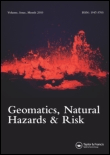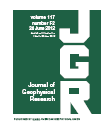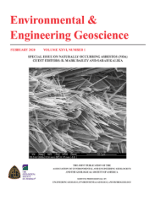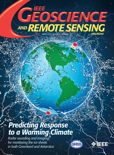
NATURAL HAZARDS
metrics 2024
Bridging theory and practice in natural hazard research.
Introduction
NATURAL HAZARDS is a premier academic journal published by SPRINGER that focuses on the multidimensional aspects of natural hazards, their impacts, and mitigation strategies. With a robust impact factor and esteemed rankings in reputable databases such as Scopus, this journal is classified in the Q2 category in Atmospheric Science and Q1 in both Earth and Planetary Sciences (miscellaneous) and Water Science and Technology, showcasing its influence in these critical fields. Established in 1988 and continuing through 2024, it serves as a vital resource for researchers, professionals, and students alike, providing cutting-edge research and insights into the dynamics of natural hazards. Although it does not offer open-access options, the journal is accessible through institutional subscriptions, ensuring that high-quality research is disseminated efficiently to those dedicated to advancing our understanding of environmental challenges. By publishing empirical studies, theoretical analyses, and case studies, NATURAL HAZARDS plays a crucial role in informing disaster management policies and strategies, thereby contributing to a safer, more resilient world.
Metrics 2024
 0.80
0.80 3.30
3.30 3.60
3.60 139
139Metrics History
Rank 2024
Scopus
IF (Web Of Science)
JCI (Web Of Science)
Quartile History
Similar Journals

Geomatics Natural Hazards & Risk
Championing Open Access Research in Earth SciencesGeomatics Natural Hazards & Risk, published by TAYLOR & FRANCIS LTD, is a premier open-access journal that has been at the forefront of interdisciplinary research since 2010, addressing critical issues related to natural hazards and environmental risk management. With an impressive impact factor and ranking in the Q1 quartile in both Earth and Planetary Sciences and Environmental Science categories, this journal serves as a vital platform for researchers, professionals, and students dedicated to advancing knowledge in these fields. The journal's commitment to open access since 2016 ensures that its high-quality research is readily available to a global audience, fostering collaboration and innovation. Located in the United Kingdom, Geomatics Natural Hazards & Risk encompasses a broad scope of studies including geospatial technologies, risk assessment methodologies, and the societal impacts of natural disasters, making it an essential resource for anyone involved in the investigation and mitigation of natural hazards.

Journal of Safety Science and Resilience
Championing high-quality research for a safer tomorrow.Welcome to the Journal of Safety Science and Resilience, a pioneering platform dedicated to advancing knowledge in the fields of safety, risk, reliability, and quality. Published by KEAI PUBLISHING LTD and based in China, this Open Access journal has made significant strides since its inception in 2020. With an impressive impact factor and a distinguished Q1 ranking in various categories, including Safety Research and Safety, Risk, Reliability and Quality, it serves as an authoritative resource for researchers, professionals, and students alike. The journal's commitment to disseminating high-quality research is reflected in its exceptional Scopus rankings, with top positions in decision sciences and social sciences. As we converge into the future with volumes planned up to 2024, engaging contributions focused on contemporary challenges and innovations in safety science are more essential than ever. Explore groundbreaking studies and elevate your understanding of resilience in the face of uncertainty through this invaluable academic resource.

ENVIRONMENT AND DEVELOPMENT ECONOMICS
Bridging Economics and Ecology for a Greener TomorrowEnvironment and Development Economics, published by Cambridge University Press, stands as a pivotal journal in the fields of development economics and environmental science. With a robust ISSN of 1355-770X and an E-ISSN of 1469-4395, this esteemed publication has been a significant contributor to scholarly discourse since its inception in 1996 and continues to thrive with a convergence of research insights expected to run until 2024. Distinguished by its Q1 status in Development and its Q2 rankings in both Economics and Econometrics and Environmental Science (Miscellaneous) for 2023, the journal reflects its commitment to high-impact research. Notably, it ranks 58th out of 306 in Social Sciences Development and maintains respectable standings in other categories, emphasizing its importance in shaping policies and practices at the intersection of economics and environmental sustainability. Researchers, professionals, and students engaged in these disciplines can access this journal for thought-provoking articles that advance understanding of economic development while addressing environmental challenges.

JOURNAL OF GEOPHYSICAL RESEARCH-EARTH SURFACE
Innovative Insights into Geophysical Challenges.JOURNAL OF GEOPHYSICAL RESEARCH-EARTH SURFACE, published by the American Geophysical Union, stands as a leading voice in the fields of Earth-Surface Processes and Geophysics. With an impressive impact factor placing it in the Q1 category for both disciplines, this journal offers invaluable insights and research findings that address critical challenges related to Earth's surface dynamics and processes. Since its inception in 2004, the journal has been dedicated to fostering a deeper understanding and interdisciplinary exploration of topics critical to environmental science, geology, and geophysics. Researchers and professionals in the field will find cutting-edge studies meticulously peer-reviewed to ensure high quality and relevance, making it an essential resource for academics, practitioners, and students alike. The journal's significant Scopus rankings — 25th out of 179 in Earth-Surface Processes and 26th out of 165 in Geophysics — underscore its influence and the rigor of its content, encouraging submission and engagement from leading scholars globally.

Progress in Disaster Science
Empowering Resilience Through Cutting-Edge ScienceProgress in Disaster Science, published by ELSEVIER, is a prestigious open-access journal that has been advancing the field of disaster research since its inception in 2019. With an ISSN of 2590-0617, the journal has quickly established itself as a leading resource, recognized for its impact across various related disciplines, as evidenced by its impressive Q1 rankings in 2023 in categories such as Earth and Planetary Sciences, Environmental Science, Geography, Planning and Development, and Safety Research. This journal publishes cutting-edge research that aims to enhance understanding and management of disaster risks, resilience, and recovery processes. Additionally, the journal's accessibility ensures that important findings are disseminated widely, fostering collaboration among researchers, professionals, and students globally. Positioned under the umbrella of critical environmental and safety insights, Progress in Disaster Science plays a pivotal role in shaping the discourse surrounding disaster management and preparedness in today's rapidly changing world.

ENVIRONMENTAL & ENGINEERING GEOSCIENCE
Bridging Knowledge Gaps in Environmental and Engineering GeoscienceENVIRONMENTAL & ENGINEERING GEOSCIENCE, published by the Geological Society of America, Inc, is an esteemed peer-reviewed journal duly established to advance the fields of geotechnical engineering, environmental engineering, and broader earth sciences. With an ISSN of 1078-7275 and an E-ISSN of 1558-9161, this journal disseminates high-quality research and innovative methodologies that address pressing environmental issues and engineering challenges. As of 2023, it is classified in the Q3 category across various disciplines within earth and planetary sciences, highlighting its contribution and relevance within the academic community. The journal boasts an impactful trajectory, converging research from 1995 to 2024, and is strategically positioned to facilitate the exchange of ideas among researchers, practitioners, and students alike. With a commitment to fostering an understanding of geosciences in relation to environmental engineering, this journal is a valuable resource for those dedicated to developing sustainable solutions in our ever-evolving landscape. Readers can access published works through institutional libraries or relevant academic platforms, ensuring that groundbreaking research reaches all corners of the discipline.

Economic and Environmental Geology
Bridging Economic Geology and Environmental StewardshipEconomic and Environmental Geology is a peer-reviewed journal published by the Korea Society for Economic & Environmental Geology, focusing on critical intersections within the fields of economic geology and environmental science. With an ISSN of 1225-7281 and an E-ISSN of 2288-7962, this journal serves as a vital platform for researchers, professionals, and students engaged in the comprehensive study of geological resources and their impacts on the environment. As of 2023, the journal is categorized in the Q4 quartile for both Economic Geology and Environmental Science, indicating its emergent impact in these domains. Despite being in the early stages of its convergence from 2017 to 2024, the journal holds importance for advancing knowledge and fostering discussions about sustainable geological practices in South Korea and beyond. The journal does not currently offer open-access options, but it continues to provide essential insights into the challenges and innovations within economic and environmental geology.

IEEE Geoscience and Remote Sensing Magazine
Fostering Collaboration for a Deeper Understanding of Our PlanetIEEE Geoscience and Remote Sensing Magazine, published by the esteemed IEEE-Institute of Electrical and Electronics Engineers Inc, serves as a pivotal platform for cutting-edge research in the realms of geoscience, remote sensing, and related disciplines. With an ISSN of 2473-2397 and E-ISSN of 2168-6831, this prestigious magazine has established itself as a leading resource in its field, achieving a Q1 ranking across multiple categories including Computer Science, Earth and Planetary Sciences, and Electrical and Electronic Engineering. Researchers will appreciate its high impact, recognized by impressive Scopus rankings—2nd in Physics and Astronomy, 3rd in Earth Sciences, and 7th in General Computer Science, placing it firmly in the top percentiles globally. Published bimonthly and compatible with various access options, the magazine aims to disseminate innovative solutions and technological advancements, fostering collaboration and knowledge-sharing among professionals, students, and industry stakeholders. As it converges its contributions from 2013 to 2024, IEEE Geoscience and Remote Sensing Magazine continues to significantly influence the scientific community's understanding of the planet and its systems.

Remote Sensing
Advancing Knowledge in Earth and Planetary SciencesRemote Sensing is a highly esteemed journal published by MDPI, dedicated to the domain of Earth and Planetary Sciences. With an impressive impact factor reflected in its rank of #16 out of 195 in the general Earth and Planetary Sciences category, this journal achieves a commendable 92nd percentile among its peers, indicating its significant contribution to the field. Since its inception in 2009 as an Open Access journal, it has enabled researchers, professionals, and students from around the globe to access high-quality, peer-reviewed articles that delve into the latest advancements in remote sensing technologies, methodologies, and applications. Based in Switzerland, Remote Sensing serves as a vital platform for disseminating innovative research that supports and enhances our understanding of Earth's processes and environments, ensuring scientific knowledge remains freely accessible and impactful.

International Journal of Disaster Risk Science
Pioneering research for a resilient future in disaster science.The International Journal of Disaster Risk Science, with ISSN 2095-0055 and E-ISSN 2192-6395, is a premier, peer-reviewed open-access journal published by Springer. Since its inception in 2011, the journal has been dedicated to advancing knowledge and practice in the field of disaster risk science, facilitating critical discussions around disaster preparedness, response, and resilience across various regions of the globe. This journal holds impressive rankings, including Q1 in Geography, Planning and Development, and Q1 in Safety Research for 2023, confirming its high impact within the academic community. With converged publication years from 2010 to 2024 and being ranked in the top 10% in multiple categories, it serves as an essential resource for researchers, professionals, and students alike. As an open-access journal, it ensures that cutting-edge research is freely available, promoting wider dissemination and engagement with topical issues in disaster risk management.